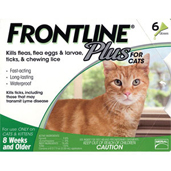The ears can be a problem area for
cats. Some conditions, like ear mites, are easily cured with simple
treatments, while others may need long term management.
Feline Ear Anatomy and Symptoms
Most ear infections affect only the
outer portion of a cat's ear -- the flap, also called the pinna, and
the part of the canal that lies on the outside of the ear drum.
A cat with an outer ear infection typically will:
- Scratch her ears
- Shake her head
- Have an abnormal discharge
and/or odor from her ears
- Have red skin and self-inflicted
wounds in or around the ears
If an ear infection has broken through
the ear drum and affects the middle ear, all of the above symptoms may
be present, but the cat may also have nerve damage, which can cause:
- A droop to one side of the face
- A sunken eye with a raised third eyelid and a small pupil
- Difficulty swallowing
Inner ear infections may also cause
the following additional symptoms:
- A head tilt
- Circling
- Difficulty standing
- Abnormal eye movements
What Causes an Ear Infection in Cats?
Most ear infections are caused by bacteria,
yeast, or ear mites. Ear mites are parasitic insects that are spread
from one individual to another, but yeast and bacterial infections are
usually caused by an overgrowth of the normal organisms that are present
on a cat's skin. This overgrowth can occur for any number of
reasons, including allergies, anatomic abnormalities, disruption of
the normal skin barrier, or a foreign body or tumor in the ear.
Veterinary Care for Cat Ear Infections
If you suspect that your cat has an
ear infection, take her to the veterinarian. The vet will need
to do two important things before coming up with an appropriate treatment
plan:
- Determine whether mites,
yeast and/or bacteria are involved by looking at a sample of discharge
under the microscope
- Determine whether or not
your cat's ear drum has been ruptured by looking in her ear with an
otoscope
If an ear infection is especially severe
or has become a recurring problem, additional diagnostic tests may
be necessary.

Your vet will recommend an appropriate ear cleaner for home use, and if necessary, prescribe
topical or systemic medications based on the results of the exam and
diagnostic tests. Many vets will thoroughly clean a pet's ears
and apply the first dose of medicine before sending the cat home.
If the middle or inner ear is involved, surgery or long-term antibiotic
therapy may be necessary.
Ear mites are widely common in puppies and pets that have recently been adopted from a group setting, such as a shelter. You might be able to diagnose
a case of mites at home and avoid a trip to the veterinarian by gently
swabbing out a sample of the discharge (it often looks like coffee grounds)
and placing it on a dark sheet of paper. If you see tiny white
specks moving around (use a magnifying glass if you have one), those
are mites. Using an ear
cleaner, followed by an ear mite pet medication, and applying a dose of Frontline Plus to the skin should get rid of the ear mites
if you follow the directions closely. All of the animals in the
household may need to be treated if they have been in contact with one
another.
Cat Ear Infection Home Care
Most ear infections require continued
care at home. If you are supposed to use an ear cleaner and/or medication, do so even if your pet
doesn't seem to like it. Finish the entire course of oral antibiotics or other medications that have been prescribed even if your cat looks
better after a few days. If your vet has recommended a recheck,
do not be tempted to skip it. Ear infections have a tendency to
recur unless underlying problems are also dealt with.
In some cases, routine ear cleaning
to remove excess wax will reduce the likelihood of an infection developing.
Try an ear drying solution if dampness
is a persistent problem.
The above is provided for information purposes only and should not be used for the diagnosis or treatment of any condition.
This information does not cover all possible variables, conditions, reactions, or risks relating to any topic, medication, or product and should not
be considered complete. Certain products or medications may have risks and you should always consult your local veterinarian concerning the treatment of
your pet. Any trademarks are the property of their respective owners.